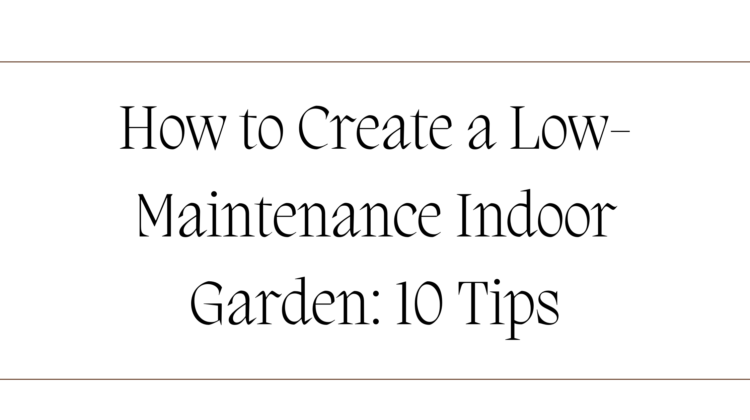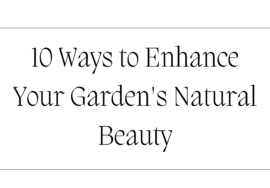
How to Create a Low-Maintenance Indoor Garden: 10 Tips
Ever wanted an indoor lush garden but were concerned about the maintenance? You’re not alone. Most plant lovers love bringing some greenery indoors, but there is always that nagging fear of how much time and effort it takes to care for plants. The good news is that you no longer have to think that making a lovely and thriving indoor garden must be a chore. In this blog, we’ll go through 10 tips on how to set up and sustain a low-maintenance indoor garden that beautifies your home and gives you happiness.
Benefits of a Low-Maintenance Indoor Garden
Starting an indoor low-maintenance garden has several advantages. First and foremost, it reduces any stress that may have been amassed due to plant care. With less time used in watering, pruning, and controlling pests, there is sufficient time left to enjoy the beauty of the plants without the stresses involved. It’s a fact that indoor plants purify air by filtering toxins and giving out oxygen. They also decorate your space, making it look more appealing and cozier than usual.
Choosing the Right Plants
The art of low-maintenance indoor gardening lies in choosing the plants. Go for hardy ones that will look nice with minimum care. Some great options are succulents, snake plants, ZZ, and pothos. All these plants have stood the test of resilience and will grow quickly according to your house conditions. Adequate plant choice sets an excellent base for an easy-to-maintain garden.
Essential Indoor Gardening Tools
Although indoor gardening may be difficult, it can easily be made simpler. Some important tools include self-watering pots, a narrow-spouted watering can, pruning shears, and a moisture meter. The idea behind a self-watering pot is to eliminate how often the plants need to be watered. A moisture meter lets you know when not to overwater, which is one of the common issues in indoor gardening. With those tools, you shall be well-equipped for garden maintenance with minimal fuss.
The 10 Tips for a Low-Maintenance Indoor Garden
Tip 1: Select Hardy Plant Varieties
Choosing plants that are naturally resilient and require little care is crucial. Among the hardy plants are succulents, snake plants, and peace lilies, which seem hardy such that they would still flourish even if one forgot to water them occasionally. Being that hardy, these plants have few insect problems and diseases and are good choices for a low-maintenance garden.
Tip 2: Use Self-Watering Pots
Self-watering pots are the best thing one can have for indoor gardening. These pots have an integrated reservoir that can release water as needed, eliminating the need for frequent watering. This proves very useful for busy people who might need to remember.
Tip 3: Optimize Light Conditions
Make sure your plants are getting some good light. Place your plants by windows to take advantage of natural light in the home. If there’s not enough sunlight, you can provide supplemental grow lights. These lights have the correct spectrum for growing, and make sure to put them on a timer to mimic regular daylighting hours.
Tip 4: Implement a Simple Watering Schedule
A consistent watering schedule can really do wonders. If you water simultaneously every week, you can either increase or decrease it based on that particular plant’s needs or the prevailing season. A soil moisture gauge may determine if one’s plants require water, hence avoiding over- and underwatering.
Tip 5: Monitor for Pests Regularly
An occasional check for pests will prevent an infestation from getting out of control. Insects, sticky residue, yellowing leaves, and other pest symptoms should prompt you to monitor your plants. You can nip any problems in the bud with a few organic remedies or local pest control services to maintain healthy plants.
Tip 6: Group Plants with Similar Needs
You may group plants that require equal amounts of light and water; this helps advance your plants’ care. Therefore, you can water and fertilize them at the same time, thus making them easier to care for. It also guarantees that all plants receive appropriate care tailored to their needs.
Tip 7: Incorporate Slow-Release Fertilizer
Slow-release fertilizers provide nutrients over time, thus reducing the number of fertilizer applications. You won’t have to worry about forgetting to feed your plants at regular intervals because these are simple to use and will ensure that they get the nutrients they need when they need them.
Tip 8: Use Quality Potting Soil
Good potting soil promotes good, healthy plant growth. Select a high-quality potting mix that affords excellent drainage and aeration. Garden soil should not be used since it compacts, restricting root growth. Quality soil reduces the need for frequent repotting as well as frequent fertilization.
Tip 9: Prune Minimally
While pruning is essential for the health of plants, it should be minimal in a low-maintenance garden. Just take off dead or yellow leaves and trim back the sprawling tips of the branches now and then. This will keep plants looking tidy without you having to attend to them all the time.
Tip 10: Choose Decorative Pots
Decorative pots make your indoor garden look better and, at the same time, reduce the frequency of repotting. Selecting pots will match your house design and be at the correct plant depth. In this way, your plants will have enough space to remain in that pot longer before they grow big and require a bigger pot.
Common Mistakes to Avoid
Avoiding these common mistakes will make your indoor gardening experience much easier. Too much water is one such mistake that can cause root rot. Always check for soil moisture before watering your plants. This follows another common mistake of putting the plant in inappropriate lighting conditions. Make sure to provide appropriate light to your plants according to their requirement. Finally, not checking for pests leads to infestations that are hard to control.
Conclusion
It’s pretty within your grasp to have a low-maintenance indoor garden. You can score a lush green space without such a hassle, from hardy plants and self-watering pots to other life hacks to make caring for them easier. Let the 10 below get you started to create that wonderful indoor garden that will enrich your home and please your mood. Remember this, however: consistency and choosing plants that will work for you, not vice versa, will be the keys to your success. Happy gardening!

